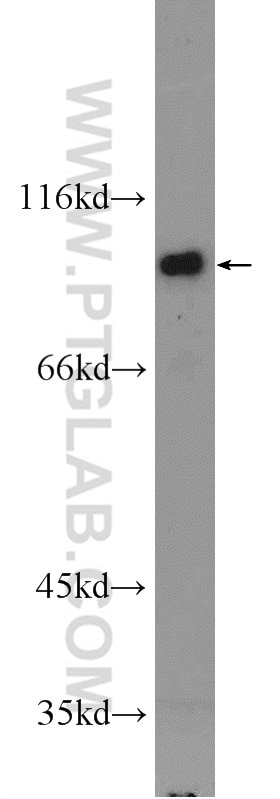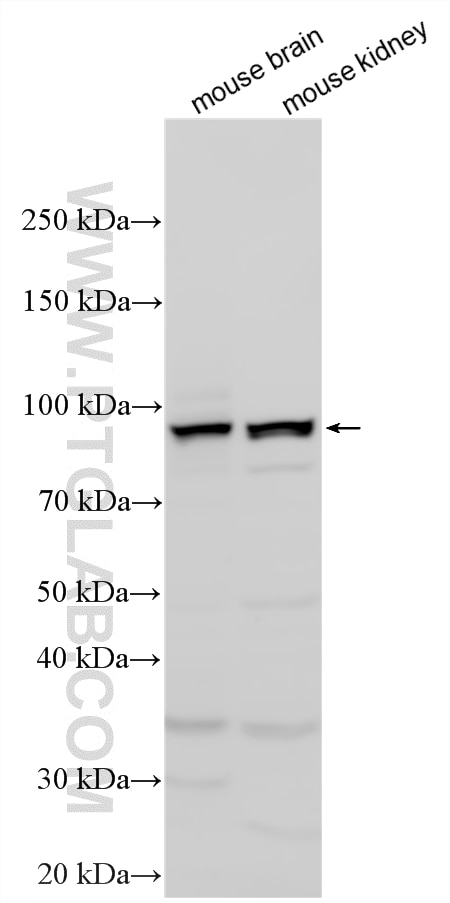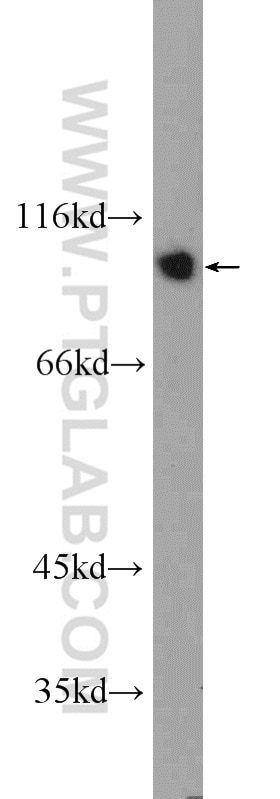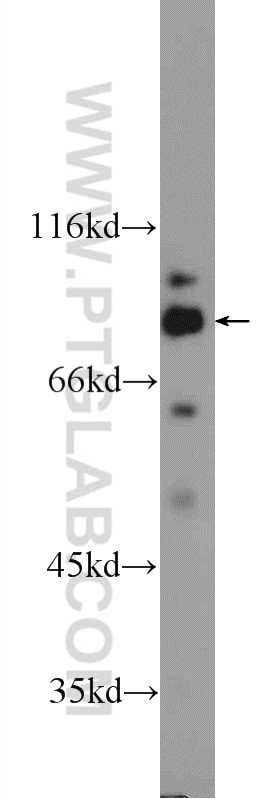Tested Applications
| Positive WB detected in | mouse brain tissue, mouse kidney tissue, NIH/3T3 cells |
Recommended dilution
| Application | Dilution |
|---|---|
| Western Blot (WB) | WB : 1:1000-1:8000 |
| It is recommended that this reagent should be titrated in each testing system to obtain optimal results. | |
| Sample-dependent, Check data in validation data gallery. | |
Published Applications
| WB | See 4 publications below |
| IF | See 1 publications below |
Product Information
25230-1-AP targets IFT80 in WB, IF, ELISA applications and shows reactivity with human, mouse samples.
| Tested Reactivity | human, mouse |
| Cited Reactivity | mouse, rat |
| Host / Isotype | Rabbit / IgG |
| Class | Polyclonal |
| Type | Antibody |
| Immunogen |
CatNo: Ag18650 Product name: Recombinant human IFT80 protein Source: e coli.-derived, PET28a Tag: 6*His Domain: 417-777 aa of BC101494 Sequence: LNAQTVSLSNDTIAIRDKADEKIIFLFEASTGKPLGDGKFLSHKNEILEIALDQKGLTNDRKIAFIDKNRDLCITSVKRFGKEEQIIKLGTMVHTLAWNDTCNILCGLQDTRFIVWYYPNTVYVDRDILPKTLYERDASEFSKNPHIVSFVGNQVTIRRADGSLVHISITPYPAILHEYVSSSKWEDAVRLCRFVKEQTMWACLAAMAVANRDMTTAEIAYAAIGEIDKVQYINSIKNLPSKESKMAHILLFSGNIQEAEIVLLQAGLVYQAIQININLYNWERALELAVKYKTHVDTVLAYRQKFLETFGKQETNKRYLHYAEGLQIDWEKIKAKIEMEITKEREQSSSSQSSKSIGLKP Predict reactive species |
| Full Name | intraflagellar transport 80 homolog (Chlamydomonas) |
| Calculated Molecular Weight | 777 aa, 88 kDa |
| Observed Molecular Weight | 88-90 kDa |
| GenBank Accession Number | BC101494 |
| Gene Symbol | IFT80 |
| Gene ID (NCBI) | 57560 |
| RRID | AB_2879976 |
| Conjugate | Unconjugated |
| Form | Liquid |
| Purification Method | Antigen affinity purification |
| UNIPROT ID | Q9P2H3 |
| Storage Buffer | PBS with 0.02% sodium azide and 50% glycerol, pH 7.3. |
| Storage Conditions | Store at -20°C. Stable for one year after shipment. Aliquoting is unnecessary for -20oC storage. 20ul sizes contain 0.1% BSA. |
Background Information
IFT80 is an intraflagellar transport (IFT) protein that plays a crucial role in the formation and function of primary cilia. IFT proteins are key for cilia formation, and it seems that this organelle has developed into a complex signaling center in mammals, providing important sensory functions. IFT80 is a recently-defined component of IFT complex B, and loss of IFT80 in zebrafish results in cystic kidneys and a reduced number of cilia, whereas silencing IFT80 in Tetrahymena thermophila produces shortened or absent cilia. (PMID: 23333501)
Protocols
| Product Specific Protocols | |
|---|---|
| WB protocol for IFT80 antibody 25230-1-AP | Download protocol |
| Standard Protocols | |
|---|---|
| Click here to view our Standard Protocols |
Publications
| Species | Application | Title |
|---|---|---|
EMBO Rep Male infertility-associated Ccdc108 regulates multiciliogenesis via the intraflagellar transport machinery. | ||
Mol Neurobiol Inpp5e Regulated the Cilium-Related Genes Contributing to the Neural Tube Defects Under 5-Fluorouracil Exposure | ||
Cell Physiol Biochem iTRAQ-Based Proteomic Analysis of Neonatal Kidney from Offspring of Protein Restricted Rats Reveals Abnormalities in Intraflagellar Transport Proteins. | ||
Cell Insight Endothelial RGS12 governs angiogenesis in inflammatory arthritis by controlling cilia formation and elongation via MYCBP2 signaling | ||
Life (Basel) The Effect of IFT80 Deficiency in Osteocytes on Orthodontic Loading-Induced and Physiologic Bone Remodeling: In Vivo Study |










